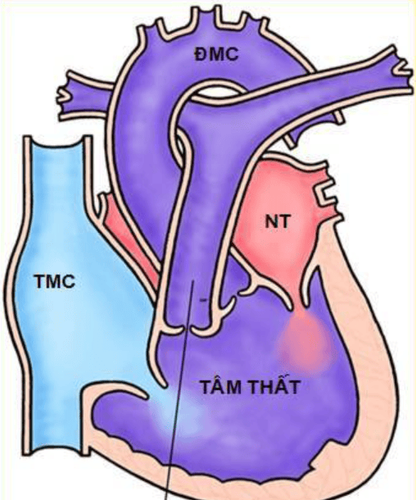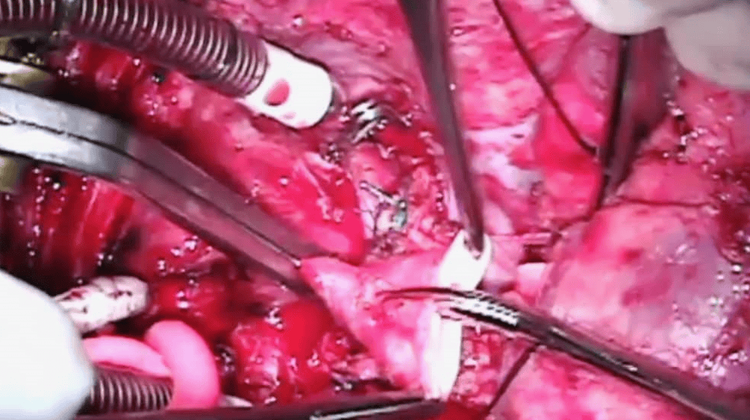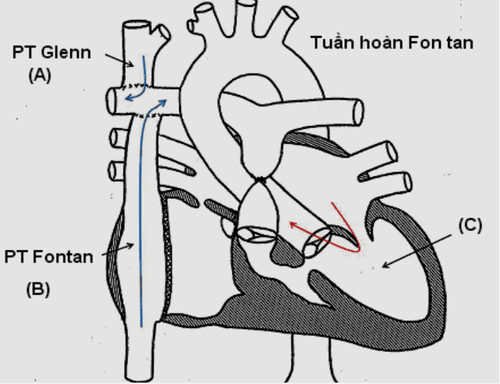This is an automatically translated article.
The article was professionally consulted with Specialist Doctor II Nguyen Quoc Viet - Interventional Cardiologist - Department of Medical Examination & Internal Medicine - Vinmec Danang International General Hospital.Univentricular heart disease is one of the rare heart defects. On average, 1 out of every 100,000 babies is born with this disability. Babies born with a single-ventricular heart defect are unlikely to develop fully. Let's find out what monoventricular heart disease is and how to treat this disability through the article below.
1. What is a monoventricular heart?
A normal heart will have 4 chambers. The upper chambers, called the atria, receive blood that flows into the heart. The lower chambers, called the ventricles, pump blood out of the heart.Whereas a normal heart has two ventricles, monoventricular heart disease is a congenital heart disease characterized by a large ventricular chamber in which the two atria empty into that ventricle either through two different orifices or through a common orifice. There may be an accessory ventricular chamber communicating with the main ventricular chamber. This definition helps to rule out diseases such as mitral or tricuspid atrophy, in which the atrophic foramen do not communicate with the atrophic ventricular chamber.
Unique ventricular heart defects can be diagnosed before your baby is born through fetal echocardiography. However, it is difficult to detect this malformation because no circulatory distortions have been observed in fetal development, because the pulmonary circulation and the normal systemic circulation are parallel, with two levels of atrium and duct connection. However, the lack of separation between pulmonary and systemic circulation causes obvious postoperative cyanosis, with severity depending on the degree of coexisting pulmonary outlet obstruction. Single ventricular cases with aortic arch obstruction are the least cyanotic because they never present with pulmonary stenosis, although these patients develop poor lower body perfusion due to constricted ductus arteriosus. again.
Often a single ventricular heart defect is not detected or diagnosed until your baby is born. Newborns may look blue or have trouble breathing. The pediatrician at the hospital may hear a heart murmur (an abnormal sound in the heartbeat) and order an echocardiogram, which will find the defect.
Most patients with monoventricular heart disease (also called single ventricle) will survive for 20 years. Patients with significant AV regurgitation have poorer outcomes. The severity and duration of presentation depend not only on the degree of aortic obstruction but also on the reduction in the size of the ductus arteriosus. The widespread use of neonatal pulse oximetry testing prior to discharge home will assist in identifying such infants before symptoms develop.
Patients with unique ventricles with genetic defects and extrasystoles often have additional risk factors (eg, preterm birth, low birth weight) and are more at risk for prolonged recovery after palliation early stage as well as higher hospital mortality.
Single-ventricular heart disease can cause complications such as:
Pleural effusion, pericardial effusion, ascites after Fontan procedure Atrial tachyarrhythmias Liver and biliary dysfunction Thromboembolism Protein-losing bowel disease Narrowing Persistent or discrete pulmonary artery Venous deformity Pulmonary artery malformation formation

2. Diagnosis of monoventricular heart disease
In most cases, echocardiography will be able to identify details of cardiac anatomy for the initial diagnosis in infancy. Echocardiography will also be important in monitoring the anatomy and function of various components of the cardiovascular system (such as valve or ventricular function) as the child grows.Cardiac catheterization is only occasionally needed in neonates with isolated ventricular malformations, if there are anatomical details that cannot be determined by echocardiography. However, patients with a single ventricular malformation will have cardiac catheterization before the second surgery (Glenn shunt) and again before the third surgery (the Fontan procedure). These methods of cardiac catheterization are done to look at the anatomy, especially of the pulmonary arteries, and measure intracardiac pressure. These pressure measurements are important in determining whether a patient with a single ventricular malformation is suitable for surgery.
Catheter interventions such as dilatation or stenting of the pulmonary artery or coil occlusion of the abnormal accessory vessels may be performed at the time of this catheterization.
3. Treatment of a single ventricle heart
Single-ventricular function is dependent on a variety of factors, including type of function, age, symptomatic status, pulmonary vasculature and pulmonary resistance, and the presence of associated defects. .3.1. Palliative Measures According to the initial procedure, many patients will need one of the palliative activities to get through the crisis and prepare the pulmonary artery for definitive repair. After the palliative procedures, the patient is periodically monitored and the repair plan is planned at the earliest optimal time.
Modified BT Shunt This is the same surgery used in patients with tetralogy of Fallot. Tube grafting is used to connect the subclavian branch of the aorta to the pulmonary artery. It is needed in patients with pulmonary stenosis causing low oxygen saturation and cyanosis. Shunt BT will increase blood flow in the lungs, improve oxygen saturation and reduce cyanosis.
Pulmonary artery strip This operation is performed in the context of increased pulmonary blood flow due to normal pulmonary arteries. This is a closed heart surgery (that is, without connecting the patient to a cardiopulmonary machine) that is performed through an incision on the left side of the chest or through a central incision to open the sternum.
The surgeon will place a narrow strip of cloth around the pulmonary artery and tighten it just enough to allow adequate blood flow into the lungs to prevent cyanosis reducing excessive flow, so that pulmonary artery pressure half the aortic pressure.
Pulmonary artery strips have some disadvantages. The tape may be too tight or too loose. Rarely, the band can travel to one of the pulmonary artery branches and narrow it. In single ventricular conditions, one of the important limitations is the later development of inferior aortic occlusion after surgical ligation.
Damus-Stansel-Kaye surgery This is another surgery that can be performed in patients with sub-aortic stenosis. The pulmonary artery divides just below the level where it branches into the right and left pulmonary arteries. The pulmonary artery is then sutured to open one side of the aorta.
Blood from the single ventricle can now flow into the pulmonary artery and then into the aorta, bypassing the narrowing area below the aorta. Pulmonary blood flow is achieved by creating a BT shunt tuned to one of the branch pulmonary arteries.

3.2. Interventions Sometimes, surgery may be needed between palliative and definitive procedures to treat complications that arise in the interim.
VSD enlargement In some cases of single ventricles, especially after the PA band, obstruction may develop in the subaortic region. Usually this is because the pre-existing VSD is shrinking. Surgery may be required to widen this VSD and increase its circulation.
Glenn Shunt Two-way In case the patient is not suitable for Fontan surgery (due to risk factors such as inferior aortic coarctation, high pulmonary vascular resistance, deformed pulmonary artery branches) but If symptoms worsen, a Glenn shunt on one or both sides can be performed, followed by a Fontan operation at a later date.
3.3. Definitive Surgery of Ventricular Separation In this surgery, an attempt is made to recreate an artificial septum in the large ventricular chamber so that blood from the left and right atrium will be separated inside the ventricle.
This is an open heart surgery done with a cardiopulmonary machine. When the heart rate stops, the surgeon opens the right atrium and assesses the ventricle through the tricuspid valve. After selecting the extent of the septum, multiple sutures are made directly into the ventricular wall. These sutures are then threaded onto a properly shaped patch made of pericardial Dacron fabric to make it less porous and reduce the risk of blood clots forming on the patch. Tie the suture, fixing the patch in place.
At this time, pure blood from the left atrium will pass through the mitral valve to the left ventricle and through the aortic valve. Impure venous blood from the right atrium passes through the tricuspid valve into the right ventricle and the pulmonary valve.
Ventricular septal defect is a major surgery with a high mortality rate, ranging from 30-40%. A major complication of this operation is damage to the heart's conduction system, causing a heart blockage.
As usual, pacemaker leads are placed at the time of surgery and many patients have to wear a permanent pacemaker afterwards.
Fontan surgery The purpose of Fontan surgery is to separate blood to ensure that only blue blood reaches the lungs and red blood is pumped to the body. This is done by connecting veins that carry blue blood from the body back directly to the lungs. This means that all the green blood from the body returns to the lungs, where it picks up oxygen. Fully oxygenated blood then travels to the heart and is pumped to the body. The difference from the normal situation is that blue blood reaches the lungs without being pumped there.
Stage 1: BT Shunt or PA Band or “Balanced” cycle. This happens during the first few weeks of life and depends on the amount of blood reaching the lungs. If blood flow to the lungs is too much, a band is placed around the main pulmonary vessel to control flow and protect the lungs from high pressure (PA Strip). The doctor will make an incision in the side of the chest. If there isn't enough blood to the lungs, another procedure called ablation surgery is performed. This procedure takes an artery that normally carries blood to the arm and redirects it to the pulmonary vessels (BT shunt). The doctor will make another incision in the side of the chest. In a situation where blood flow to the lungs is "balanced", no initial manipulation is required.

Stage 3: Complete Fontan / Connect the whole lung cavity (TCPC). This occurs some time after the second period, usually in late childhood, but sometimes early in adult life. This surgery directs blood back to the heart from the bottom of the body in the direction of the pulmonary vessels. It is done by connecting the inferior vena cava (IVC) to the right pulmonary artery.
All people with Fontan cycles need lifelong follow-up. Complications become more common over time. These include heart rhythm problems (for example, too fast, too slow, or irregular), blood clots, liver problems (caused by high pressure in the liver veins), and impaired heart function.
4. How to take care of patients with monoventricular heart?
Follow-up appointments with a child's cardiologist during infancy and childhood are important to minimize the risk factors associated with monoventricular heart defects. Your child will need a series of diagnostic tests between planned surgeries.Once the surgeries are complete, your child will have appointments with the pediatric cardiologist once a year or more often. The child may need additional surgical therapy, catheterization or, in rare cases, a heart transplant.
Most children treated for single-ventricular heart defects will not need regular medication, although some children may need daily aspirin to prevent blood clotting.
When it comes to physical activities, in most cases parents should allow children to play as much as possible. Tell children to stop activities if they start to strain their bodies. There are also certain sports and activities to avoid.
As children get older, try to maintain a healthy weight and aim for a BMI between 20 and 25. This is even more important for people with Fontan circulation to keep their heart functioning properly for time. long. There is some evidence that good muscle strength can help blood flow back to the lungs more efficiently. Regular moderate exercise, including light-medium weights (up to 20kg) is good for overall cardiovascular health and for the Fontan circulatory system.
In a nutshell, monoventricular heart disease is a congenital heart disease characterized by a large ventricular chamber in which the two atria empty into that ventricle either through two different orifices or through a common foramen. The severity and duration of the disease depend not only on the degree of aortic obstruction but also on the reduction in the size of the ductus arteriosus.
Currently, Cardiovascular Center - Vinmec International General Hospital is one of the leading centers in the country for examination, diagnosis, screening and treatment of cardiovascular diseases. Vinmec not only has the convergence of a team of experienced and reputable leading experts in the field of surgical treatment, internal medicine, interventional cardiac catheterization, but also has a system of modern equipment, on par with The most prestigious hospitals in the world such as: MRI 3 Tesla (Siemens), CT 640 (Toshiba), high-end endoscopy equipment EVIS EXERA III (Olympus Japan), high anesthesia system Avace level, Hybrid operating room according to international standards... Especially, with the space designed according to 5-star hotel standards, Vinmec ensures to bring patients the most comfort, friendliness and peace of mind. .
Please dial HOTLINE for more information or register for an appointment HERE. Download MyVinmec app to make appointments faster and to manage your bookings easily.














